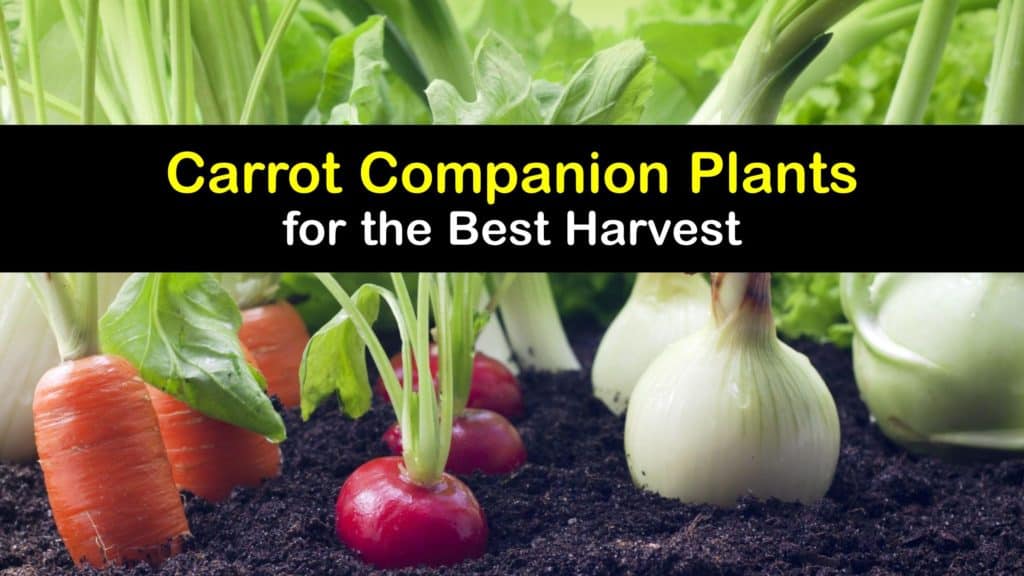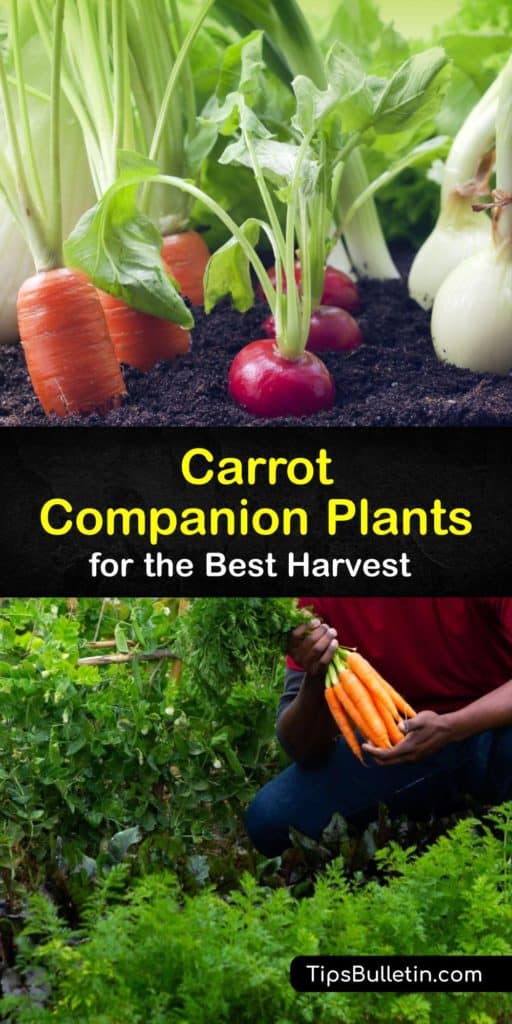Carrots are a charming addition to any home garden, and they do quite well with a good companion. There are plenty of plants out there, and it’s hard to know which is beneficial for your garden. We’ve taken the guesswork out of companion planting carrots with this quick reference guide so you can simply get growing this season.
Companion planting is a beneficial gardening strategy used across all cultures for thousands of years. Great companions reduce the need for weeding, invite beneficial pollinators, and effectively deter pests. Certain legumes such as pole beans and bush beans even amend depleted nitrogen levels, helping your carrots grow strong.
Carrots come from the Apiaceae family, including parsnips, celery, and fennel. Domesticated in Asia about a thousand years ago from the Daucus carota, or wild carrot, they are now grown worldwide. Modern carrots have a delicious root, have high vitamin A levels, and are rich in beta-carotene content.

Learn What to Grow with Carrots
If you have a lovely carrot patch planned this year, why not learn what to plant with carrots for a bountiful harvest. A good carrot companion planting strategy deters pests, increases yield, and enhances the flavor of your carrot crop. Nothing tops fresh, crunchy carrots right out of the vegetable garden.
How to Plant Carrots
Before we get to carrot companion planting, let’s go over some easy carrot care. Most hardiness zones in North America consider the best growing season for carrots is early spring planting, after the final frost, and before the summer heat.
However, if the temperature remains moderate in your area (rarely over 85°F), feel free to plant multiple crops of carrots throughout the season without the worry of the plants going to seed in the heat.
When you are looking for the best way to plant carrot seeds, choose a sunny space in your vegetable garden with 6 to 8 hours of daily light. Expert gardeners recommend direct-sowing the carrot seeds into garden soil or raised beds, as transplanting them from pots often makes bent, forked carrots.

To ensure you’re growing thick, straight carrot roots, use loose, well-draining, loamy soil with a pH of 6.0 to 6.8. Use your garden trowel to carve the planting rows one inch deep and ten inches apart, and sprinkle a handful of slow-release 10-20-10 fertilizer into the seed trench before sowing.
Epsom salt is another homemade fertilizer you can use in your carrot garden to deter pests and add nutrients to the soil. Epsom salt is good for carrots as it adds the extra nutrients the plant needs for optimal growth.
Carefully plant the tiny carrot seeds down the row about one inch apart, cover, and water well. Carrots reach maturity in about two months and require regular thinning of the smallest plants and consistent weeding to preserve nutrients in the soil.
Try Flowers in the Vegetable Garden
Flowers for the vegetable garden might seem strange, but companion planting carrots with beautiful bursts of chamomile, hyssop, and bee balm greatly enhances biodiversity.
Flowers naturally attract beneficial insects and pollinators, which help your fruits and vegetables flourish. Companion flowers bolster your crop because they reduce common garden pests and preserve the quality of your carrot harvest.
Grow plenty of marigolds if you’ve wondered what to plant with carrots to keep beetles and nematodes away. We can’t say enough good things about the underrated marigolds out there.
Commonly known as calendula, they are a favorite of hungry pests like Japanese beetles, bean beetles, and cucumber beetles and make a great distraction crop. Marigolds also repel nematodes, a significant cause of forked roots in your carrot patch and the bane of any carrot farmer’s growing season.
Aphids are often a concern when companion planting carrots, so why not try nasturtiums this year? Not only are nasturtiums cheerful and beautiful, aphids love them and will ignore your tender baby carrots completely.
The flowers and leaves of nasturtiums are edible and look great on a summer savory salad. If you prefer a garden staple like the geranium, they’re also known to have repellent properties. There are so many beneficial flowers, and we know you’ll find the right variety to complement your garden.
Companion Planting Carrots with Aromatic Herbs
Carrot foliage smells wonderful to common garden pests like flea beetles, aphids, and carrot flies. Sometimes it feels like there’s no way to keep them out; this is where planning what to grow with carrots benefits you. Aromatic herbs help mask the enticing scent of your carrots, which keeps pests moving on to other things.
Grow strong-smelling aromatic herbs like rosemary, oregano, and even catnip to disguise your vegetable garden. Or, try beautiful herbs like borage or spearmint to add a cheery “summer cottage” feel to your space.
Most aromatic herbs complement carrots, though avoid other members of the Apiaceae family (or umbellifers). Cilantro, coriander, and dill easily cross-pollinate and often result in some inedible hybrids.
Are You Still Wondering What to Plant with Carrots?
If you’re still trying to decide what to grow with carrots, how about some cabbage family members called Brassicas? Many Brassicas like kohlrabi and cauliflower grow mostly above-ground and don’t compete with your carrots for space. Grow carrots next to Brussels sprouts too. They can also provide a little shade for your carrot plants.
Plant other Brassicas like turnips to lure cabbage moths from your main crop; horseradish is a repellent for aphids and soft-bodied bugs. Carrots grow well with radishes for the same reason.
Are you bored with Brassicas? Alliums are another perfect choice as your carrot companion. Plant carrots with garlic or other Alliums like chives and leeks since they smell repulsive to many home garden invaders like aphids and produce beautiful flowers that bring bees to the yard.
There’s very little that can’t be considered when dreaming up your garden (even corn stalks), but always avoid planting crops from the same family in proximity. Other Apiaceae like parsnips, fennel, and cilantro attract the same pests and make your vegetable garden extra-vulnerable.
Easy Honey-Glazed Carrot Recipe
Everyone loves an easy side dish after a long day. Put all those carrots to good use with this soon-to-be favorite honey-glazed carrot recipe. This recipe is made for improvisation; add any other veggies from companion planting carrots in your garden. Try new things as you go.
Fill a medium-sized pan with two inches of water, and bring it to a boil. Add one teaspoon of salt and your fresh carrots, lower the heat and cook until tender – about ten minutes.
Drain the carrots, put them back in the pan, and stir in the honey, butter, black pepper, thyme, and remaining salt. Stir for about two minutes until the carrots are beautifully glazed, and serve with chopped parsley.
We hope you loved this quick-reference guide for companion planting carrots. This growing season, create a simple companion strategy and build on that as you observe results and gain more confidence.
Choose companions with similar light and nutritional needs that also repel pests, increase yield, or are simply beautiful. Plant flowers, legumes, aromatic herbs, or strut your know-how and grow all of them. You have infinite gardening possibilities right at your fingertips this season and every season.

If you enjoyed these tips for companion planting carrots, share them with a friend on Pinterest or Facebook who wants a perfect patch of carrots for this year’s harvest.